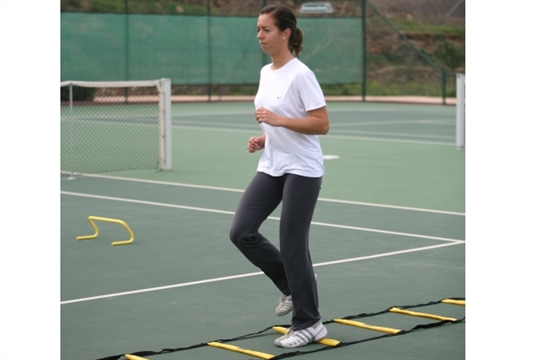Tennis specific movement training

A Tennis player needs to be able start and accelerate from a stationary position, make a series of movements to cover the court then decelerate to strike the ball using static or dynamic balance, as a result of making a powerful stroke the player will be out of balance and will need to recover balance and change direction to prepare for the next stroke. A player will use a series of patterns of movements, these patterns are specific to Tennis and can be broken down into five phases of movement, these are:
- Split Step - how to un-weight and prepare for the first movement. The split step is the fastest way to change from being stationary to moving. Normally timed to when your opponent contacts the ball, initiated by visual clues.
- First Move - the first move is dependent on the direction and how far the player needs move to make contact with the ball, the choice of first move is a reaction to the speed, shape and direction of the opponents shot. Advanced players link the landing of the split step with the first move.
- Movement - the series of steps to cover the court, e.g. side steps, run, crossovers, power step.
- Preparation - the final adjustment/re-adjustment balancing and loading action to prepare to make contact with the ball.
- Recovery - the series of linked movements to recover balance and change direction to return to a central position on the court.
The type of movement during these phases is dependent upon where the player is when they start, where they need to be to hit the ball and the type of stroke they are going to make.
Although the movement can be considered to be five phases, the phases should link to together so that the result is a series of fluid movements in which the phases are difficult to be identified.
The movement training must be performed on the surface on which the player is going to compete. The movement technique required to accelerate, decelerate, hit the ball and recover to a central position on the court is different for each surface.
Basis movements can be trained and improved using a series of exercises, and when these have been acquired the Tennis specific movements can be trained and improved.
A vital part of this basic movement training is the development of Agility, Balance Coordination and Proprioception.
- Balance is the ability to hold the Body in positions that are controlled. Static Balance is when the body is stationary. Dynamic Balance is when the body is held in a stable position for short periods of time in what is basically an unstable position.
- Agility is the ability to change the body position from one position to another quickly in a controlled manner, the easiest example of this is a player starting and stopping.
- Coordination is the ability to change the body position using a series of fluid controlled movements whilst maintaining balance.
- Proprioception is the understanding of the position of the body in relation to the surrounding area and the ground.
Agility, Balance Coordination and Proprioception can be improved in basic movements.
Tennis specific movements are a series of movements constructed from fundamental basic movements.
Normally a player who has difficulty in performing the basic movements will not be able to perform the Tennis specific movements efficiently. As a player becomes more advanced they will use explosive movements more frequently. To perform the explosive movements efficiently without injury, the player will have had to improve their strength using a series of exercises.
SAQ (Speed Agility Quickness) is a method developed by SAQ International, this method is used to quickly improve the basic movements of a player, initially concentrating on the mechanics of the movement, then improving the speed of movement whilst developing Agility, Balance and Coordination.
Once the basic movements have been learnt and can be practiced efficiently, the Tennis specific movements are introduced by incorporating exercises developed for Tennis and exercises developed by the iTPA, LTA, ITF, USTA and other sources.
The majority of basic movements are applicable to all Sports and the analysis methods used to develop the Tennis specific movements, can be used to develop movement exercises for other Sports.
Look in Junior Coaching and Adult Coaching for current courses.